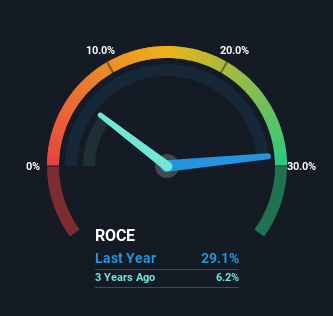Investors Shouldn't Overlook The Favourable Returns On Capital At Starbucks (NASDAQ:SBUX)
There are a few key trends to look for if we want to identify the next multi-bagger. One common approach is to try and find a company with returns on capital employed (ROCE) that are increasing, in conjunction with a growing amount of capital employed. Basically this means that a company has profitable initiatives that it can continue to reinvest in, which is a trait of a compounding machine. So, when we ran our eye over Starbucks' (NASDAQ:SBUX) trend of ROCE, we really liked what we saw.
What Is Return On Capital Employed (ROCE)?
If you haven't worked with ROCE before, it measures the 'return' (pre-tax profit) a company generates from capital employed in its business. The formula for this calculation on Starbucks is:
Return on Capital Employed = Earnings Before Interest and Tax (EBIT) ÷ (Total Assets - Current Liabilities)
0.29 = US$5.8b ÷ (US$29b - US$9.4b) (Based on the trailing twelve months to December 2023).
So, Starbucks has an ROCE of 29%. In absolute terms that's a great return and it's even better than the Hospitality industry average of 9.5%.
View our latest analysis for Starbucks
In the above chart we have measured Starbucks' prior ROCE against its prior performance, but the future is arguably more important. If you'd like to see what analysts are forecasting going forward, you should check out our free analyst report for Starbucks .
What Does the ROCE Trend For Starbucks Tell Us?
We'd be pretty happy with returns on capital like Starbucks. The company has consistently earned 29% for the last five years, and the capital employed within the business has risen 36% in that time. With returns that high, it's great that the business can continually reinvest its money at such appealing rates of return. If Starbucks can keep this up, we'd be very optimistic about its future.
What We Can Learn From Starbucks' ROCE
In short, we'd argue Starbucks has the makings of a multi-bagger since its been able to compound its capital at very profitable rates of return. In light of this, the stock has only gained 36% over the last five years for shareholders who have owned the stock in this period. So to determine if Starbucks is a multi-bagger going forward, we'd suggest digging deeper into the company's other fundamentals.
One final note, you should learn about the 2 warning signs we've spotted with Starbucks (including 1 which is significant) .
High returns are a key ingredient to strong performance, so check out our free list ofstocks earning high returns on equity with solid balance sheets.
Have feedback on this article? Concerned about the content? Get in touch with us directly. Alternatively, email editorial-team (at) simplywallst.com.
This article by Simply Wall St is general in nature. We provide commentary based on historical data and analyst forecasts only using an unbiased methodology and our articles are not intended to be financial advice. It does not constitute a recommendation to buy or sell any stock, and does not take account of your objectives, or your financial situation. We aim to bring you long-term focused analysis driven by fundamental data. Note that our analysis may not factor in the latest price-sensitive company announcements or qualitative material. Simply Wall St has no position in any stocks mentioned.

 Yahoo Finance
Yahoo Finance 
